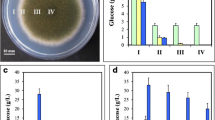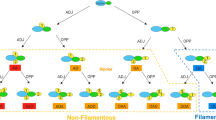Abstract
Podospora strains mutated in two loci (incA orincB) differ from wild-type strains in an unscheduled aerial development of hyphae at the boundary of colonies. Culture in liquid media limited for various nutrients (glucose, acetate, pyruvate, nitrogen, or sulfur) showed that the cells from the tips of hyphae of onlyinc mutant cultures did not survive to nutrient exhaustion. It thus appears thatinc strans are defective in a nutritional growth control, resulting in a shift of the metabolism pattern of apical cells that provides resistance against various nutritional deficiencies. In contrast, the quiescent stage specific to cells of the basis of hyphae ensures cell survival for only glucose limitation.
Similar content being viewed by others
Literature Cited
Bernet J (1965) Mode d'action des gènes d'incompatibilité et relation entre l'incompatibilité cellulaire et l'incompatiblité sexueller chez lePodospora anserina. Ann Sci Nat Bot 26:611–768
Durrens P (1983)Podospora mutant defective in glucose-dependent growth control. J Bacteriol 154:702–707
Durrens P (1984)Podospora anserina mutations reducing cell survival under glocose staryation. Exp Mycol 6:216–224
Durrens P, Bernet J (1982)Podospora anserina mutations inhibiting several developmental alternatives and growth renewal. Curr Genet 5:181–185
Durrens P, Bernet J (1985) Temporal action of mutations inhibiting the accomplishment of quiescence or disrupting development in the fungusPodospora anserina. Genetics 109:37–47
Esser K (1974)Podospora anserina: In: King RC (ed) Hand-book of genetics, vol. 1. New York: Plenum
Fraenkel DG (1985) Onras gene function in yeast. Proc Natl Acad Sci USA 82:4740–4744
Pardee AB (1974) A restriction point control for normal antimal cell proliferation,. Proc Natl Acad Sci USA 71:1286–1290
Prillinger H, Esser K (1977) The phenoloxidases of the assomycetePodospora anserina: action and interaction of genes controlling the formation of laccase. Mol Gen Gen 156:333–345
Rizet G, Engelman C (1949) Contribution à l'étude d'un ascomycète tétrasporé:Podospora anserinal. Rev Cytol Biol Veg 21:201–304
Schiaffonati L, Baserga R (1977) Different survival of normal and transformed cells exposed to nutritional conditions nonpermissive for growth. Cancer Res 37:541–545
Sudbery PE, Goodey AR, Carter BLA (1980) Genes which control cell proliferation in the yeastSaccharomyces cerevisiae. Nature (Lond) 288:401–404




